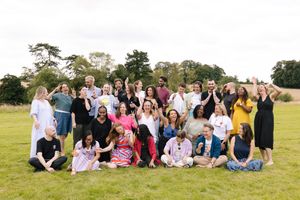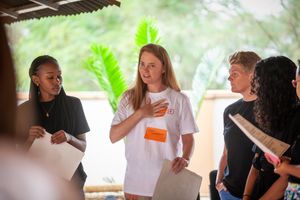Why complex global problems need ‘adaptive bureaucracies’ (and why that’s not an oxymoron)

For most people the idea of an adaptive bureaucracy might seem like an oxymoron. But the fact is, much of the work we need our governments to do involves working on highly complex issues, which makes linear, multi-year planning a chocolate teapot.
I personally believe it’s the use of these teapots that has resulted in some of the biggest failures in public service. There are some famous UK-based examples, like the NHS digital transformation that got shelved with a total bill of £10bn in taxpayers money; or the cancellation of Phase Two of the HS2 high-speed railway.
We’ve all worked on something that we know is failing, or isn’t going as well as we’d hoped. We have all gotten to the end of a project and thought something like ‘I’d do this differently if I could start again’. We’ve all reached a point in a project where we’ve learned something new and wished we could integrate it as a fresh thread or workstream.
These moments are a given. What’s not a given - and has to be intentionally designed - is a culture in which people aren’t afraid to raise a hand if things aren’t as they’d hoped they should be, setting clear moments and flexible mechanisms that allow teams to make good use of those insights when they happen. Intentionally designing processes for people to follow the insight, not the plan.
Over the past few years Brink has had the great privilege of working with some of the most inspiringly adaptive bureaucracies. We’ve supported them to accept uncertainty and build the methods, mindset and mechanisms to create impact in the midst of change. Here’s what we’ve worked on together.
1. Make change predictable
The realities of government programming is that you’ll most often need to set out a five year business plan to get started. Within that long-term plan, there are ways to make room for adaptation.
Instead of the standard ‘mid-term report, annual report and final evaluation’ approach, you can break your five-year goal into chunks of work with stop/start/continue points along the way, with your signals of success clearly marked out at the relevant stages.
Here are some key things to consider as you go:
- Reframing risk: If it feels too risky to create moments to recast the work that needs to be done, consider the alternative: not adapting. In an uncertain context, it’s more risky to just pursue one strategy that might not be right, than it is to experiment with a few options to see what works first.
- But don't adapt without a good reason: If you know what you need to do to get the job done, an adaptive approach that encourages contemplation is probably a waste of time and money. If you’re, say, building a bridge, doing that in 'build, measure, learn' sprints is just a different kind of chocolate teapot.
- Making space: Teams have to ‘get off the dance floor and onto the balcony’. Pre-plan timeouts and review points to stop, take a step back and reflect on the action from a distance. On our programmes we have started using an adapted version of the ikigai to do this and support teams to think big.
2. Create portfolios to test novel ideas alongside 'business as usual'
If you’re not clear on the best route to achieve your goal, take a portfolio view - think about how you’d balance more certain strategies, with bolder, less certain options, running in parallel.
A portfolio is useful because it says ‘We don’t know how to achieve the goal yet’ and allows you to test a few ways. Remember, just because you can set out a plan that feels linear and predictable does not mean the world will fall into place for that plan.
By definition it means stopping things that aren’t fruitful too. Here’s what you need to consider:
- Accountability, done differently: This is not an invitation to be random. Portfolios demand a different kind of accountability. A clear goal, theses, measures of success — a portfolio without these isn’t adaptation or innovation, it’s gambling.
- Consider routes and weight them: Structure your portfolio against a golden ratio of 70/20/10. Give the routes that are most likely to deliver impact 70% of your time and financial resources, adjacent ideas 20% and the side bets 10%. Our friend Ann Mei Chang encourages us to think in terms of Engine 1 and Engine 2, it’s a similar framework where the first engine gets most of the work done and is managed as a more predictable set of initiatives while engine two is experiments with the riskier ideas that might have outsized impact longer term.
- Plan formal gates for reflection and decision-making: Use timely reflection points or gates within your plan to stop doing things that aren’t working and reinvest that effort in things that are. Compare your portfolio against a north star, do less of what’s failing, more of what’s working.
3. Use evidence to inform, not just evaluate
A lot of ‘measures of success’ in government are there to monitor and evaluate and essentially govern suppliers, asking “has this supplier done their job?”. Adaptive programmes need to use data to inform what happens next; to ask “What do we know now that we didn’t know before?”
- Blending qualitative and quantitative approaches: While an adaptive programme might use quant measures to account for change, this needs a qualitative component that asks ‘why’ and understands nuance in order to inform what happens next. In high performing adaptive programmes the quant data piques curiosity about what’s really going on, inspiring the generation of richer hypotheses which can then go on to be tested in the next phase of work (note the next ‘phase of work’ not the next programme of work). These learning loops have to be faster than between years-long programmes if we’re aiming for more impact, faster. In other words, a theory of change that is updated and reflects what the team has learned, not one that sits on the shelf in between annual reviews.
- Value learning as an outcome: Make learning an outcome and optimise all your processes in line with that. If you are setting up a big research project, consider mechanisms like payment-by-learning which Brink designed into the Frontier Technologies Hub. Remember, the power dynamics in donor/grantee relationships often means grantees are quite set in the way of telling donors what they believe they want to hear. If you really want to learn, honesty has to be incentivised. Or, to be basic about it, put your money where your mouth is.
- Beware the vanity metrics: Forget measures that focus on hard numbers, which tell you nothing. Knowing that x thousand people were reached may be good for your ego but it tells you little. Is that a lot, or most of the people, or a small fraction? Meaningful measures, by comparison, tell a story, like rate of production, adoption as opposed to people reached. This will help us to make better decisions and, of course, correct where needed.
4. Foster a culture capable of experimentation
Managing adaptive teams demands that we undo the old orthodoxies of leadership. Adaptivity isn’t about command and control. It’s about fostering an environment that supports experimentation and learning, including providing incentives to work adaptively and embrace uncertainty.
- Our brains register uncertainty as pain. Getting organised about facts and guesses can ease this human discomfort. When you know something, act on it. When you guess something, run experiments to test whether you’re onto something; and when you don’t know, explore possibilities through research.
- Give yourself more time: Adaptive programmes take more time and greater collaboration. For new pieces of work, successful teams have been seen to set out a longer startup period to set up for success and ensure alignment.
- Using novel approaches can be lonely: Find friends and other like-minded people who are working in similar ways. Support and encourage one another.
- Speak the same language: Lingo can create bigger divisions when used without intention and without first getting on the same page, so take time to make sure you all mean the same thing.
5. Set your partners up for success
Humans change from one context to another - think about how different you are when talking to your best friend's mother who you've just met, or your best friend at the pub. Context shapes behaviour and contracts are context for working with others. Contracts shape behaviour.
How a partnership is framed will, in large, part be dependent on the procurement/contractual arrangement in place. Check, and then double, triple check incentives to make sure your call for adaptivity isn’t just lip service. Fixed milestone delivery payments fly in the face of adaptive working, for instance.
- Learning as an outcome: An alternative to a focus on outcomes is to shift the way we look at measuring how partners are delivering on the ground. The kinds of things we’d be looking for include: conduct tests, use evidence, generate good evidence and applied learning… without preempting what the tests or evidence will be.
- This doesn’t mean a lack of accountability: Instead it’s about new forms of accountability that build upon change as a given. Hold teams to account by asking for rich insight: we ask these questions, based on US Army after action reviews: what did you think was going to happen, what did happen, why was there a difference and what will you do differently next time? It’s their answer to this question that matters most.
An earlier version of this was first published on Apolitical in August 2019 to capture work done by Brink and ODI with the then Department for International Development (DFID). It marked the end of a three-year project called LearnAdapt. Our job was to explore and codify the ways teams in the department might embrace adaptive management.
Much has happened since then and now - a global pandemic, increased conflict, climate shocks, global recession, mental health recessions - making frameworks and tools to navigate complexity with clarity and confidence ever more relevant and hopefully useful.





